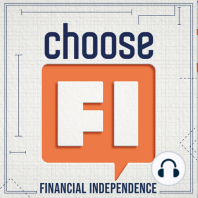67 min listen
276 | How to Set up Your Financial Life | Investing and Banking
FromChooseFI
ratings:
Length:
52 minutes
Released:
Dec 7, 2020
Format:
Podcast episode
Description
Continuing the conversation discussing financial basics, today's episode covers how to get started investing, banking, and setting up your financial life. As a recent college graduate, Brad had the motivation to get his financial life together but didn't really know how to go about doing it. During his first job, he wanted to open up a Roth IRA after learning about the power of compound interest. Unfortunately, the investment advisor who helped get him set up invested in a fund with a 5% upfront load. That means 5% of his investment automatically went to pay the advisor's commission. Brad'sinvestment was treated like a quick payday for the advisor. Not all financial advisors are bad, but you can learn how to get set up with a low-fee or no-fee investment without feeling confused or overwhelmed by the process. It's important to understand all of the possible fees that can impact the return on your investment. In addition to load fees, there are other fees to watch for, such as assets under management fees where you pay a percentage for the advisor to manage your account, or expense ratios which pay the team who actively manage the activity of buying and selling within the fund account, and with a surrender charge, you may pay fees to get your money out of the investment. If Jonathan was giving a family member financial advice on how to get started, it would begin with banking. Do they have a banking system set up and understand the differences between checking and savings accounts? What other variables should be considered? Getting a checking account set up is first and becomes the repository for income coming in and money going out, such as paying bills. Brad uses autopay to have many bills automatically draft from his checking account. Brad likes simplicity. Because he knows which days money will be coming in, he sets up his bill autopay dates around that. He also ensures he has a couple extra thousand dollars in his checking account to cover anything unexpected with him having to track the balance every day. Jonathan does something similar in that he uses the pay from last month to pay this month's bills, which means there is always around a month's worth of pay in his account giving him plenty of margin. Try to minimize fees in every aspect of your life. Select a bank account option that requires the lowest minimum account balance to avoid a monthly fee. Avoid overdraft fees by asking the bank to remove that option or connect to a credit card. Don't pay ATM fees by trying not to use cash or plan ahead and withdraw cash from your own bank fee-free. Some online banks will reimburse ATM fees. Brad doesn't keep all of his financial assets in a checking account. He used to use a saving account at the same bank that was connected to his checking account. However, it earned very little in interest. Online savings accounts, like those at CIT Bank, frequently offer a much higher interest rate on their savings accounts and still allow access to the money within 2-3 business days. Your investing goals are determined by two items: your cashflow and what sort of safety net you need. Money that might be needed in the short-term and accessible within days, such as for emergencies, should be kept in cash in a savings account. Money that isn't needed for 10 years or more, should be invested because money can lose value over time due to inflation. Instead, that money can be making money and beating inflation. To maintain value, your money needs to make 1-3% per year just to keep pace with inflation. Knowing how much to keep in savings and when to move to investing depends on your risk tolerance. Make sure your bank is FDIC insured, which means it's backed by the United States Government and covers depositors in the event of bank failure. Once you have a checking account set up and you are putting away something each month into savings, getting started investing would be the next step. Brad says the best place to get started is with your comp
Released:
Dec 7, 2020
Format:
Podcast episode
Titles in the series (100)
018R | Capital Gains Harvesting | Never Pay Taxes Again | Part 2: In Today’s Podcast we cover how to harvest long term capital gains tax free. Friday Roundup 7 Review of Monday’s episode with Jeremy from Go Curry Cracker Brad and his family just visited Washington DC for the weekend and used Chase Ultimate... by ChooseFI
